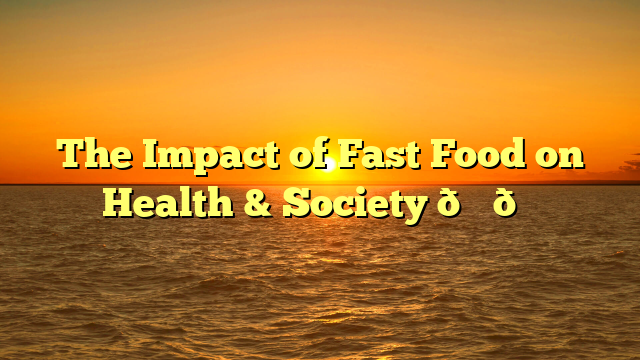
Fast food is a dominant part of modern eating habits, offering quick, cheap, and tasty meals. From McDonald’s to KFC, fast food chains have become global giants, shaping diets and lifestyles worldwide. However, while convenient, fast food has significant impacts on health, economy, and culture.
In this article, we’ll explore how fast food affects health, its role in society, and the growing movement toward healthier alternatives.
1. The Rise of Fast Food 🚀
Fast food became popular in the mid-20th century, with chains like McDonald’s pioneering the “speedy service” model. slot demo mahjong thrived due to:
⏳ Convenience 💰 Affordability – Fast food is cheaper than home-cooked meals 🌍 Global Expansion – Fast food chains expanded across every continent 📢 Marketing & Branding – Aggressive advertising targeted children & families.
Today, fast food is a multi-billion dollar industry, shaping eating habits worldwide.
2. Health Risks of Fast Food ⚠️
While fast food is delicious, it often contains high levels of fat, sugar, and salt, leading to serious health issues:
🍔 Obesity Epidemic – Regular fast food consumption is linked to weight gain. In many countries, obesity rates have doubled or tripled in the last 50 years.
💉 Diabetes & Heart Disease – Fast food is high in trans fats & refined sugars, increasing the risk of Type 2 diabetes and cardiovascular diseases.
⚡ Nutritional Deficiency – Most fast food lacks fiber, vitamins, and minerals, leading to poor nutrition and weakened immunity.
🧠 Mental Health Effects – Studies suggest fast food can impact mood, energy levels, and brain function, increasing the risk of depression and anxiety.
🚸 Impact on Children – Fast food chains aggressively market to kids, influencing their lifelong eating habits. High sugar and fat intake in childhood leads to early obesity and health problems.
3. The Social & Economic Impact of Fast Food 💰
Fast food is not just a health issue—it also affects society and the economy:
🏭 Job Creation & Low Wages – Fast food chains employ millions of workers but often pay minimum wages with limited benefits.
🌱 Environmental Damage – The industry contributes to deforestation, excessive water use, and plastic waste from packaging.
🏡 Changing Family Culture – Traditional home-cooked meals are being replaced by fast food dining, reducing family bonding time.
🛍️ Influence on Shopping Habits – Fast food chains partner with supermarkets and delivery services, increasing processed food consumption.
4. The Rise of Healthier Alternatives 🌱
As awareness grows, many people are turning to healthier food choices. Fast food chains are adapting by offering:
🥗 Salads & Plant-Based Options – Many brands now offer vegan, vegetarian, and low-calorie meals.
🥤 Healthier Beverages – Reducing sugary sodas and introducing smoothies, herbal teas, and water.
🍗 Better Ingredients – Some chains are moving toward organic, antibiotic-free meat & fresh produce.
📱 Tech & Customization – Apps allow customers to customize meals, track calories, and make healthier choices.
5. How Can We Make Healthier Choices? 🤔
Even if fast food is unavoidable, we can make better eating decisions:
✔️ Choose Grilled Over Fried – Opt for grilled chicken or fish ✔️ Pick Smaller Portions – Avoid super-sized meals ✔️ Drink Water Instead of Soda ✔️ Add Vegetables – Choose meals with salads, fruits, or whole grains ✔️ Limit Fast Food Frequency – Treat it as an occasional indulgence, not an everyday meal.
6. Conclusion: Finding a Balance 🍽️
Fast food isn’t going away, but we must be mindful of its effects on health and society. With growing awareness, consumers are demanding better, healthier, and more sustainable options. By making smarter choices, we can enjoy convenience without sacrificing well-being.
Do you think fast food chains should be responsible for offering healthier meals? 🍔❓




